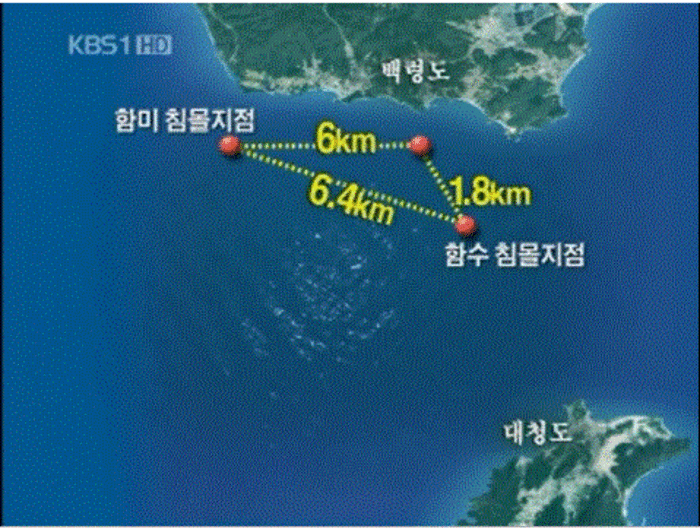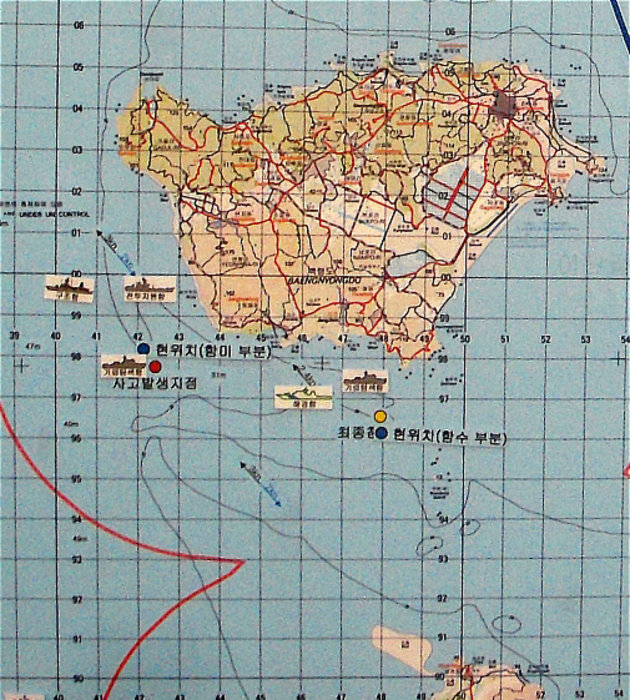Who Sank the South Korean Warship Cheonan? A New Stage in the US-Korean War and US-China Relations
Tanaka Sakai
Introduction
At 9:22 on the night of March 26, the 1,200 ton ROK Navy corvette Cheonan was severed in two and sank in the waters off Baengnyeong Island, a contested area that is the closest point of South Korean territory to North Korea. Forty-six crew members died and 58 of the 104 member crew were rescued. It was the worst ROK naval disaster since 1974 when a navy landing ship capsized killing 159 sailors.
Nearly two months later, the elaborate political choreography of explanation and blame for the disaster continues on the part of North and South Korea, China and the United States. The stakes are high: ranging from an easing of tensions on the Korean peninsula to a new stage of fighting in the Korean War. With polls showing that 80 percent of ROK citizens believe that the sinking was caused by North Korean attack, tensions remain high. While segments of the US, European and Japanese mainstream press have exercised caution in jumping to the conclusion that a DPRK ship had attacked the Cheonan, the international media have shown no interest in following the leads opened by South Korean media and citizen researchers.
An ROK-sponsored four nation investigation is pending, involving the United Kingdom, the United States, Sweden and Australia. On 18 May, The Korea Times reported that investigators have found pieces of the torpedo screw that sunk the Cheonan, and that it is of a type manufactured exclusively by China and Russia. US Secretary of State Hillary Clinton is scheduled to discuss the issues when she visits Seoul shortly after the completion of the review, which is expected around 20 May. What is perhaps most clear is that important information has been suppressed by the US and South Korean authorities.
n the article that follows, pioneering independent journalist Tanaka Sakai opens new windows on the case and hypothesizes about what may have happened on the night of March 26 and after. Drawing on ROK TV and press reports and photographs, some of which were subsequently suppressed, Tanaka places at center stage a range of factors, some fully documented, others speculative, that have been missing, distorted, or silenced in US and ROK narratives: they include the fact and location of the US-ROK military exercise that was in progress at the time of the incident and the possibility that the Cheonan was sunk by friendly fire. Tanaka also presents evidence suggesting the secret presence of a US nuclear submarine stationed off Byaengnyong Island, the possible sinking of a US vessel during the incident, the role of US ships in the salvage and rescue operations that followed, the failure of the submarine USS Columbia to return from South Korea to its home port in Hawaii, and the death of an ROK diver in the attempt to recover that vessel.
At stake are issues that could rock the ROK government on the eve of elections, and could impinge on the US-ROK military relationship as the US moves to transfer authority over command to ROK forces by 2012, and to expand the role of China in the geopolitics of the region. There are implications for tensions between North Korea and the US/ROK on the one hand, and for the permanent stationing of US nuclear, and nuclear-armed, submarines in South Korean waters. Above all, there is the possibility that renewed war may be imminent in the Korean peninsula. Mark Selden
__________________________________________________________
On 26 March, 2010 near Baengnyeong Island (White Wing, also known as Baekreong) to the South of the northern limit line, the maritime demarcation line between South and North Korea, South Korea’s large patrol boat Cheonan (Heaven’s Peace) exploded and sank. Already, more than one month after the accident, the cause of the sinking has not been confirmed. In early April, the South Korean government announced that either a torpedo struck or an underwater mine exploded, sinking the ship, indicating that it was not destroyed by an explosion or accident inside the boat but by an external cause.
| The stern of the Cheonan docked on a barge off Baengnyeong Island on 7 May, 2010. Lee Jung-hoon. |
However, it remains an enigma as to who fired or set off a torpedo or underwater mine. The South Korean right, claiming that a North Korean semi-submersible ship fired a torpedo, demands that the South Korean government launch a revenge attack on the North. The left and pacifists in the South suggest that the warship may have touched off an underwater mine installed in the 1970s by the South Korean military to prevent North Korean infiltration and still left there.
Baengnyeong Island is only 20 kilometers from North Korea in an area that the North claims as its maritime territory, except for the South Korean territorial sea around the island. At present there are two demarcation lines on the sea. South Korea and the US (UN) claim that the Northern Limit Line (NLL), which runs just north of Baengnyeong Island, is the demarcation line between North and South. However, since 1999, North Korea has claimed that the Military Demarcation Line further south is the border between North and South. About 5,000 South Koreans live on Baengnyeong Island and regular ferries link it from Inchon. In the reconciliation between North and South in the year 2000, North Korea recognized this ferry route and the sea around the island as an area where South Korean and American boats can navigate freely. At the same time, North Korea has regarded American and South Korean boats entering the sea area beyond that as violating the economic zone of North Korea.
Map of Baengnyeong Island (1)
Map of Baengnyeong Island (2)
In the vicinity of Baengnyeong Island South Korea constantly confronts the North Korean military. The Cheonan was a patrol boat whose mission was to survey with radar and sonar the enemy’s submarines, torpedoes, and aircraft, and to attack. If North Korean submarines and torpedoes were approaching, the Cheonan should have been able to sense it quickly and take measures to counterattack or evade. Moreover, on the day the Cheonan sank, US and ROK military exercises were under way, so it could be anticipated that North Korean submarines would move south to conduct surveillance. It is hard to imagine that the Cheonan sonar forces were not on alert.
South Korean military spokespersons told the media immediately after the incident that the probability of sensing torpedoes two kilometers away with sonar was over 70 percent. Later the probability was reduced to over 50 percent because the water is only 30 meters deep. This reduction, I believe, is for the purpose of theorizing North Korean responsibility for the attack.
The patrol boat sinking; doubling the area of the search
A US Submarine that sank by the Number 3 Buoy
The sinking of the Cheonan remains unsolved. But around the time of this incident another sinking occurred that has hardly been reported in Japan. Near the site of the sinking of the Cheonan, a colossal object, which appears to be a US submarine, was found to have sunk. An ROK underwater team searched for, and on April 7 South Korea’s KBS TV showed, a US helicopter carrying what seems to be the body of a US soldier. KBS is a public broadcasting station with the highest credibility in South Korea.
Following the sinking of the Cheonan, in the course of conducting an underwater search, a member of the special unit of the ROK Navy, UDT-SEAL (Underwater Demolition Team, Sea Air Land) Han Joo-ho, lost consciousness and later died. This was a secondary disaster. While collecting information on the death of Warrant Officer Han, KBS learned that his memorial took place neither near where the rear of the ship was found (the first buoy), nor near where the head of the ship was found (second buoy). Rather, it was six kilometers away near the third buoy, between the first and second buoy, that is, at a location that had nothing to do with the Cheonan sinking.
A map provided by KBS TV. The third buoy to the East of Baengnyeong Island is where the head of the Cheonan sank, and the rear of the Cheonan sank to the West.
The map of the search generally reported: two black dots to the South of Baengnyong are where the halves of Cheonan reportedly sank. The third buoy is not shown.






![[URGENT PLEA: In Update] EMERGENCY in GANGJEONG Since AUG. 24, 2011](https://blogger.googleusercontent.com/img/b/R29vZ2xl/AVvXsEiQvpaNf6EePZVucu97_JphYsFS5IgumnSiA4YAmen1PZcim6vMmW7XjZ7J6nLh-Cu36mwBN5n1evrA3ey0vYMpwlAGsgnSFggv6a1w4Qx9BvvqOB0hy0BIcBkL2Exfs3zIxBsBuDGa1kzg/s227/jejusit.jpg)



![[Solidarity from Japan for the Jeju] 253 individuals and 16 groups/organizations](https://blogger.googleusercontent.com/img/b/R29vZ2xl/AVvXsEivji7100kBkr0hzvqYfh4IBBilkZ6XgDIg89jOxS6kTssxsVKC6Wm-fZbKOEsiy3zcO-9gW6GHspD5R_2C9WsGx5S1Z5VPj_OVRF7H6dxdaT0S-2H1eqsDsYvIwOV26VscxTHnKmP5iZmh/s227/jeju_12_10j.jpg)

![[Translation] Korean organizations' statement: Immediately cancel the joint ROK-US drill Nov 26](https://blogger.googleusercontent.com/img/b/R29vZ2xl/AVvXsEgfKDMo-qyEjm5asUtHlREyJY_5Ou-2tyB8SH6aUxiViRbbKR-8W_rirFiGp5DYSoD_KaeNOPMWR0af0ZPUIbJKmR89ImDvADHsGAIqsJVBvJNBEIl5wLd3G_zhPDW3Z2SxsHXadOsXe8st/s227/1.jpg)
![HOT! [Hankyoreh Hani TV] Beneath the Surface: the investigation into the sinking of the Cheonan](https://blogger.googleusercontent.com/img/b/R29vZ2xl/AVvXsEh80rL3Qv9GnfHSqbYMfivdqX5gZN-1O_VQj3A_Gk3yjWdybHwJCsprA3l6cEQB0cYCP2oNeaLo2ohLGIy0Uqqkv_fRkBevGJ2f-qkKD5eP1ZGsKeQ-r-jHUUb79WvucIN7hpEtXza4xXCL/s227/HaniTV+Cheonan.gif)



![[Translation]Statement against illegal inspection and unjust lay-off by the Kunsan USAFK!(Nov_2010)](https://blogger.googleusercontent.com/img/b/R29vZ2xl/AVvXsEg3JlQ-lreusCIJo5Yv2e3ZrRwrSMUE7UQxlrDVjmBehl0Pa24QZIAbZ5vUpgnnExbkKL9PdCwxVYSHWJkr_XK0FM4EhU3CMFhqfborVNu_p4v3bEFpNm3ia-aEHnvMMuEBI27aB7_BETuJ/s227/gunsan+protest.gif)
![[Translation] Korean organizations' statement against dispatching special force to the UAE on Nov.](https://blogger.googleusercontent.com/img/b/R29vZ2xl/AVvXsEiU7TNhTDLLwZkKP0Z78JsCZKp6je-QSFll3_ThmLES_y_nPLXEzeakrsZXoNxhN5blopEhy6xGV2tneJrniPdTR-JvOQMmSLr_HhlucxFvbusxk4oKvvMO2laBOHSIkB9OOeOxrQlqCA0O/s227/antiwarpeace.jpg)
![[Translation] Stop, Joining MD!: South Korean activists' statement and writing on Oct. 25, 2010](https://blogger.googleusercontent.com/img/b/R29vZ2xl/AVvXsEggGIHVei8j7LCJPJB5HIrspd942q436daNTquP-pFd45Cl70Ml_1JFiFDHgKu6FcoqNgFVKIFqjeuSPau2k_BwGHhx0cqFFL2-4ybZSTlmua0_AsERBtKYQa7jZk7uNj41LX6rj2vksHbo/s227/StopMD.jpg)
![[In Update] People First, NO G-20 (Nov. 6 to 12, Korea)](https://blogger.googleusercontent.com/img/b/R29vZ2xl/AVvXsEhZl8VTqeL7o2ndliGIE-sZFCikbTgfB9KCc3AtZvDaYijBBEhdfultMEOpyrCaD5gzpH8mqfWjU20KXMbSUl-5KM7yQeHU6z3BWV8tiOy4UKaCudz9VKWoi5x58xdC_gQpJTjkR5u7O9xf/s227/left21_G20.jpg)
![[International Petition] Stop US helipad plan in Okinawa to save great nature](https://blogger.googleusercontent.com/img/b/R29vZ2xl/AVvXsEihgYmdb0N8ViPvTFC_5i-Psbt4eX_LnAUEOtZkUngv_pGvRyWag1r6W60NicLLyTgWq-sPT1hBxLY5SadEIVv5McfZQ5uIhe-W0VoflQNqojsYZjFW6AH-gB1jsmSDGnGuKIFk2UkvNbFG/s227/yanbaru_w.jpg)

![[Global Network] against the first launch of Quasi-Zenith Satellite, Japan, on Sept. 11, 2010](https://blogger.googleusercontent.com/img/b/R29vZ2xl/AVvXsEj2sYpfodDDMIA7qXwuda0DmKapxXFB479fDnn8RKy7QNZqz0VEvWucNd-DleZ37hWNXC-Z8QtaqtM37VuPwac5SgclJ9_khBBSWOedvm19MRXIP1j1kcWrK6EW5IFjQdEEY2h7E6xuyNvC/s227/Qzss-45-0_09.jpg)

![[In update] Some collections on the Koreans’ protests against the sanction & war on Iran](http://4.bp.blogspot.com/_gnM5QlRx-4c/TJMvke6t8zI/AAAAAAAAFO4/tamQ8LUnOOA/S227/No+Sanction+on+Iran.jpg)
![[Three International Petitions] to End the Korean war and peace treaty(or peace resolution)](https://blogger.googleusercontent.com/img/b/R29vZ2xl/AVvXsEhlohLVYtpCg7iMsZhNYY4hBbhTi2dIheHMHWLDph9X2y78cjgZV1LeSfUJeu80elhJm70Q9E059q72lK-spSPvsRG4bPuCDIytltJB9IH3mWt9OG98HqhnTsPakwhvNeoCFUgF1xoxQ2EZ/s227/border.jpg)



![[Collection of Documents] No Base Learning and Solidarity Program_Korea(June 14 to 20, 2010)](https://blogger.googleusercontent.com/img/b/R29vZ2xl/AVvXsEix_HzjToh3nNGHBc-_5gasq-ykcaZ6GInLixILmZVyRJ5xoeHCxWOyYd9fSM7bmnuFsjSrYOGEPnQOwB1Dcyo-sN4Pw0cFPhUtKig_qlVnGL1Wi82ClvPqbEPWYhJiqdNF0DyzLIBETMB9/s227/No-Base-banner.jpg)
![Site Fwd:[John Hines] A U.S. Debate coach’s research trip on the Issues of Korea](https://blogger.googleusercontent.com/img/b/R29vZ2xl/AVvXsEg8yRra0zNhKHN74Auqhd3Nx9tZ7BWCGflRJHGH4CfzBT_yjhZ8Nl9b3OZuLpYWJ2exsjmR0oVl-Qq_cf832p2VdmOZhUi-lCFzCNeDSyVtweX1lWZPC-RlHmDMLtilHwHjNFTenBiM4Fk4/s227/Jeju-Peace-Tour.jpg)


![[News Update] Struggle Against the Jeju Naval Base since Jan. 18, 2010](https://blogger.googleusercontent.com/img/b/R29vZ2xl/AVvXsEhKfSTRC5QKBBSFIq_m7QIqXdlbL4-gF5GJYn9Q-pN__k7sV7uxGDcLY5L8xmU7QuWuUhBT_GhG-URBPO80RT3AfWfDrWJr06h1hFuZC6ZBVKe4U6PS1Cd7Kr6olO8TYQtk13Drox7IS6ea/s226/scrum1.jpg)


![[Urgent] Please spread the Letter!: There was no Explosion! There was no Torpedo! (May 26, 2010)](https://blogger.googleusercontent.com/img/b/R29vZ2xl/AVvXsEhSd2yWZ3xGwnJQXB73z5FgXCqSosAoB9_33-GLYprOmLqjmvgSAQp1BYI7e4slK1FDxHRi9KK4um-OpDaj8QOkXwAScVAgvvq6-ehbDA-hbkr96wT9oHNNmWnBPv8GU4hoZp9X8F9AZBX4/s227/grounded.jpg)
![Text Fwd: [Stephen Gowans]The sinking of the Cheonan: Another Gulf of Tonkin incident](https://blogger.googleusercontent.com/img/b/R29vZ2xl/AVvXsEi_L6hB3RZ1MovTXHe0A8yn_RfgMALGR0kM6poBuGp809xwvHtB_-PGWtS_WpyPWatyd9lB2pPqL2gOLc4dTCEdJ9sMvxJWEdapl-mMLm7WHAsV-jVpgqarVh8XBtdz_0c-Vohdh3HtJahD/s227/lee-myung-bak.jpg)
![[Japan Focus]Politics in Command: The "International" Investigation into the Sinking of the Cheonan](https://blogger.googleusercontent.com/img/b/R29vZ2xl/AVvXsEiHmTo8v-uCJnabRhMdnBAkC9J3s5bb2JsDKiT5leJHwbK8IDJHxfJmqQ_C0Is_bPC6UGMf05CA0exF2y4r2x9RhFUHT0kjsKviaME_MZXKnq775UyYAdb7w2SAzE75XvBfHp1al2q6i3cf/s227/wen_jiabao_and_lee_myungbak.png)
![[Japan Focus] Who Sank the SK Warship Cheonan? A New Stage in the US-Korean War and US-China](https://blogger.googleusercontent.com/img/b/R29vZ2xl/AVvXsEiKSS5ULT5QBaMGYpXXqBMX9jtwLwMLuK469b6Ku72GTJYKUObzTANaPjZqvvpPzYMJgPF53sjhvhK3DVa88ipYlggsJageykXlkxY6s8TW05xcU-_vfhf-pACUoaWuFbT-fsU1qEhm_yIi/s227/buoy_map.gif)
![[Updated on 12/13/10] [Translation Project] Overseas Proofs on the Damages by the Military Bases](https://blogger.googleusercontent.com/img/b/R29vZ2xl/AVvXsEikADE6JovUNspQyZUWVMTLAQg7yQNqXpVUbqZPk8f4uc_1723_xm1Cco6WAmstQXVPnaJAcb1mZA8Ny_3xONT_f5uh8MNLPnUhtqdGgy3HCtC1Vbbz4Q0ZY1Cssu-4cJEVNdrvznbS5UzO/s227/missile.jpg)
![[International Petition] Close the Bases in Okinawa](https://blogger.googleusercontent.com/img/b/R29vZ2xl/AVvXsEhNpQiHklwFbWVlFK7GDFXnBSOOSFEj3Il-We-N3uTDldKiidL2NGZs7X_LtTnatzTo_r8CexRkFe8NhfxYqmgp1knEEslROTfNjI5_mSb57cdbhPkftvanveYBaevAD9xuKDGoIxiTwoSb/s227/2.jpg)

![[In Update]Blog Collection: No Korean Troops in Afghanistan](https://blogger.googleusercontent.com/img/b/R29vZ2xl/AVvXsEjjEmCRXSNAG7_QBxKWbdksmxoWR4nyAovQTTdR1G2AuXh0jxtqNkI9OmYgYWRoLAJShvtBvE840QXuBWSVh3u3zMYqkNAFX6OWy3m5Nur4HM7uNK-pKT1ycyApJp-VLyhIFRRcoisYAh0E/s226/No-Troops-to--Afghanistan.jpg)











No comments:
Post a Comment